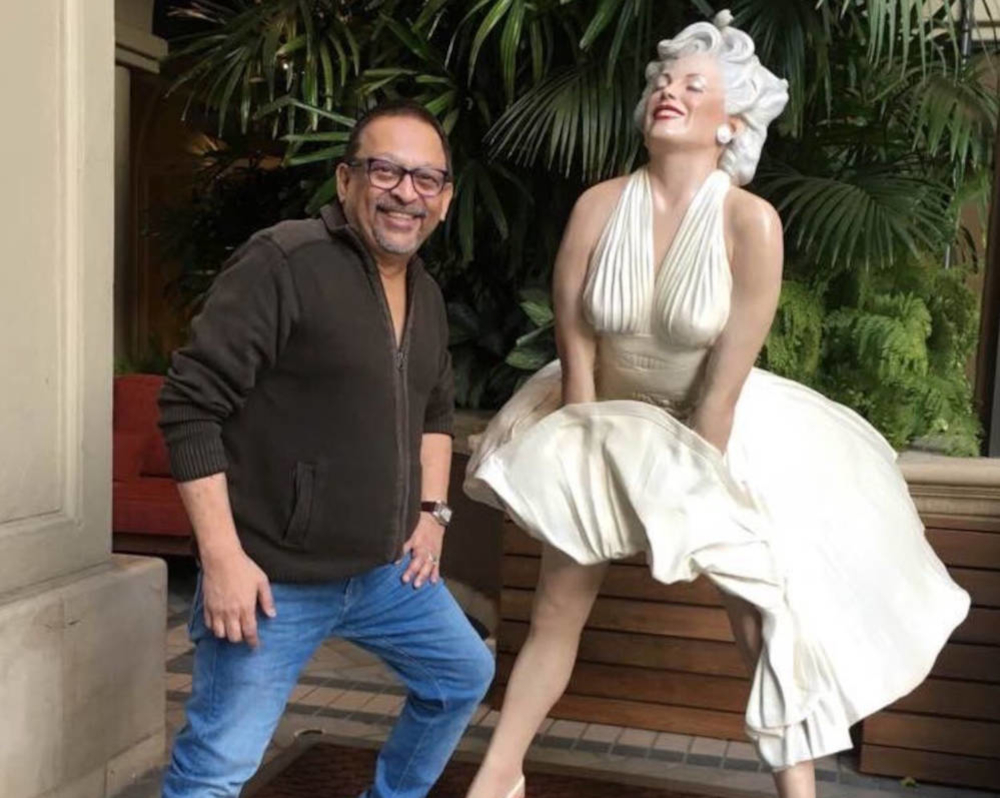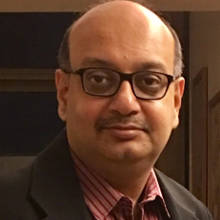[Photo via Instagram]
Everyone who has ever worked with Pradeep Guha will possibly have a unique story to tell about the legend. As do I. Except that I worked with him for exactly a year in the early phase of my career. I am aware of the many distinctive aspects of PG’s life: as a film producer, mega event conceptualiser, celebrity talent spotter, builder of institutions, marketing whiz…But there’s a lot more that I’m hoping to discover, as more people share their memories of him. What I’ve chosen to put together here is my short personal account. Of the man I saw up close and personal, who literally changed media marketing forever. Someone who dreamt big and believed in living life king-size, by combining creative imagination with a razor sharp intellect. Especially, at a time in the late eighties and early nineties, when the business of media in India needed a visionary like Guha to creatively package and help build a new business model.
My first encounter with him was in 1989, when he hired me as a Response Executive, one among nine others, from a pool of 300-plus applicants. I had just moved to Mumbai (then Bombay) after completing my graduation from St Xavier’s College, Calcutta. Mumbai offered better career opportunities. And soon after I arrived, a print ad in The Times of India caught my uncle’s eye. He encouraged me to apply for it. I was already enamoured by the media industry, but I had no clue what space selling entailed, except what I heard from my brother, who had done a stint with the same department at The Times well over a decade ago.
The interview turned out to be a breeze. It seemed as if PG, as he was called, had already decided he would hire me. “Very impressive credentials,” he told me, peering down from his thick black pair of spectacles. I suspect what did the trick wasn’t any accomplishments at school or college. I had two referees, one the legendary Shunu Sen, the then marketing director at Hindustan Lever, and the other, Suren Chawla, a media stalwart and former media director at HTA, the country’s largest ad agency (now called Wunderman JWT). PG must have figured that two giants must have seen something special in a callow 21-year-old for them to agree to be a referee. Little did he know that all that glitters isn't gold! I didn’t let him down though. In fact, the next one year that I spent at the Response department was easily the most exciting and rewarding initiation into the world of media and marketing one could have hoped for.
No young professional could have asked for a better start to one’s career. Working in a modern office—perhaps one of the best designed offices of its kind in the country at that time—had its perks. (Like, showing around relatives from Calcutta who turned up for a dekko.)
It wasn’t just a fancy office. At its very core, Response was an exciting place to work back then. Right from the start, PG had moulded it in his own style. Executives were expected to be well-groomed and presentable, just like their dapper boss. He successfully elevated a largely commoditised space selling to solution selling. Newspapers became brands. The ordinary ad rate card was transformed into the Mastermind. For national advertisers with big budgets, it offered media planners and buyers a complex web of packages covering different publications of The Times of India group. Similarly, for SMEs or local traders, there were similar tailored packages. In many ways, Mastermind was a masterstroke. Because it smartly piggybacked on the flagship The Times of India Mumbai edition, to sell a bunch of other group publications that advertisers may not have otherwise considered. PG always did things in style. He threw massive parties for staff and clients at the Taj (I unceremoniously passed out in the middle of the first one that I attended. I was reliably told PG let out a chuckle when he enquired about the casualty list the next morning).
When Mastermind was launched, most media buyers couldn't quite figure it out at first. And that is exactly what PG had bargained for. He wanted media buyers and clients to depend on us, his army of Response executives and managers. And we knew Mastermind like the back of our hands. PG saw to it that we did. We’d go for pitches, armed with data culled from NRS reports. Upselling and cross-selling were buzzwords that I added to my vocabulary even before I joined business school.
Those were really heady days in the world of media marketing. Every Saturday morning, we’d troop into the conference room, where PG would share his perspectives on the media business for at least three hours. We would latch on to every word he spoke.
This is where I heard about perceived value pricing for the first time, an idea that PG had been evangelising and presenting at every major conference. I had read transcripts of his talks (there were no YouTube recordings of live sessions in those days!). And it gradually became apparent to me that the concept of perceived value pricing wasn’t just another superficial marketing gimmick, it permeated everything that Response—and the rest of the organisation—did to change perceptions of its key stakeholders, including the new look that Hafeez Contractor gave the Response department.
(Simply put, perceived value pricing is determined by how much customers were willing to pay for a certain product or service based on the value they could derive from consuming it. It wasn’t linked to the cost of the product itself. Now this was significant. The Times group believed the price of its advertising space needn’t have anything to do with the cost of producing a morning broadsheet newspaper. As long as it could shape customer perceptions, advertisers and media buyers would end up paying more for its brands. Guha was a master at helping the company create a halo around the brand.)
This was also the first time that I heard of The Independent. I’m not sure exactly whose brainchild it was. But PG was very clear that we needed a top end brand to flank The Times of India. The logic was clear: as with every large heritage brand, The Times ran the risk of trying to be everything to everyone. Instead, with a flanker brand, you could safeguard your flanks against an attack by a rival—and also expand your total market share than what ToI could possibly garner on its own. At a simplistic level, The Independent could pursue the classes—even as ToI nurtured its core mass market clientele and dominated the well of the market.
As the young maverick owner, Samir Jain was already coming into his own. In PG, he had a dynamic general manager heading the Response department. He hired the redoubtable Satish Mehta, the marketing whiz from ITC, as his new director, marketing. And then there was NP Singh, the genteel, sophisticated director of Response, whom PG would take over from, before eventually taking over as CEO. It was a dream team. The sesquicentennial celebrations in 1988 had provided a sneak peek into what the next gen of the family had in mind.
(And just a year or two after I left, the team embarked on an overhaul of The Economic Times, with a bagful of tricks, including invitation pricing, supplements like Brand Equity, Corporate Dossier and Investors Guide.)
Under Vinod Mehta’s editorship, The Independent was expected to set new standards in design production and editorial quality. And it did all that. It was pure class. Exactly like PG had told us in the third floor conference room. And we went to town to drum up interest among the media planners, buyers and advertisers.
Meanwhile, the much-anticipated launch turned out to be a damp squib. Much to our horror, on the day of the launch, the paper simply didn’t get delivered to readers. The launch had been sabotaged internally. A section of employees, in the circulation department, were convinced that its launch would hurt the fortunes of The Times of India in Mumbai, and therefore, could bring ruin to the company. PG wasn’t one to be rattled by such setbacks. Without even breaking into a sweat, he gave us specific instructions: to physically hand over copies of the paper to the ad agencies and advertisers every day till the issue was sorted out. And he suggested we call it a soft launch! The gambit didn’t entirely undo the damage, but the concept of a soft launch for the next two weeks did save us the blushes.
During my short stint, there was a large-scale exodus from the Response Department. Most of our seniors in the department decided to leave and join The Sunday Observer at fancy salaries. There was talk that PG would move as well. After all, he commanded enormous loyalty among his people. And people would jump ship if there was an opportunity to work with PG at the next gig. But whatever transpired, much to the dismay of the folks who had crossed over, he stayed on at The Times. (I recall all along PG loved encouraging colleagues to keep checking their market value. Perhaps this time, he did so and decided it was best to stay put.)
Luckily for some of us, he decided to have a few critical teams report directly to him. As the Display team, we got a chance to work with him. For us, there were other perks at play. Whenever we were in his office, we’d get interrupted by incessant calls on his landline. I still recall some of his long telephone conversations with Roopa Ganguli, the reigning star in those days who performed the coveted role of Draupadi in Mahabharata. We would cheekily eavesdrop on the conversation, but he carried on nonchalantly. Most of these big name stars trusted him implicitly for advice. And he knew how to charm them off their feet.
One final word: Before I completed a year at Response, I decided to sit for the Bombay University’s Common Written Test (CWT), the admission test for entry into Masters in Management Studies (MMS) programme. I applied for admission at SPJIMR. At the interview panel, my hands-on year-long experience at Response helped enormously. The marketing professor was duly impressed that I understood the concept of perceived value pricing—and could explain how it could be applied in a newspaper business. Those Saturday morning learning sessions had paid a rich dividend, after all.
When I put in my papers, my performance appraisal was still due. I was pleasantly surprised to receive a hefty increment, even though the boss knew that I was leaving. Perhaps it was his small way of acknowledging my contribution. And for not letting him down the day he hired me.
RIP, PG. I owe you a big one!
Postscript: For reasons I can’t fathom, somehow my path didn’t cross with PG ever again, even though I joined advertising from campus, before eventually switching over to a career in business journalism. Perhaps I should have made a greater effort to stay in touch. And that’s a regret that I will hold on to.


